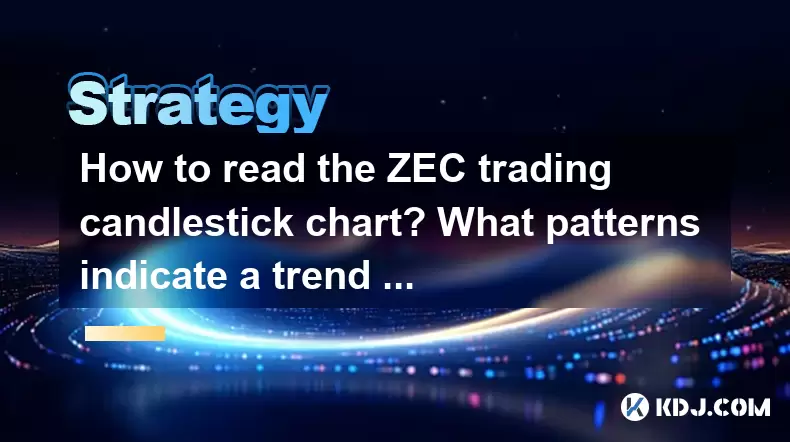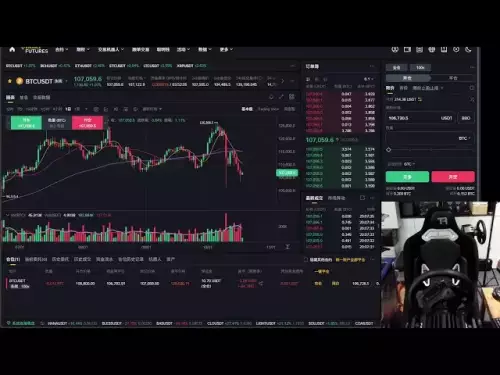-
 bitcoin
bitcoin $106975.071866 USD
-0.29% -
 ethereum
ethereum $3871.670850 USD
-0.07% -
 tether
tether $1.000261 USD
-0.01% -
 bnb
bnb $1084.417621 USD
-0.50% -
 xrp
xrp $2.348167 USD
0.82% -
 solana
solana $185.621736 USD
0.45% -
 usd-coin
usd-coin $0.999833 USD
-0.04% -
 tron
tron $0.313423 USD
0.81% -
 dogecoin
dogecoin $0.188856 USD
0.54% -
 cardano
cardano $0.630416 USD
-0.49% -
 hyperliquid
hyperliquid $36.506353 USD
2.24% -
 ethena-usde
ethena-usde $0.999584 USD
-0.01% -
 chainlink
chainlink $16.750026 USD
-0.77% -
 stellar
stellar $0.313373 USD
0.37% -
 bitcoin-cash
bitcoin-cash $465.978560 USD
-1.57%
How to read the ZEC trading candlestick chart? What patterns indicate a trend reversal?
Learn to read ZEC candlestick charts for informed trading: identify trend reversals with patterns like Hammer, Shooting Star, and Engulfing. Use with other indicators for best results.
May 07, 2025 at 03:42 pm

Understanding how to read the ZEC trading candlestick chart is essential for any trader looking to make informed decisions in the cryptocurrency market. Candlestick charts provide a visual representation of price movements over time, and they can help traders identify potential trend reversals. In this article, we will delve into the specifics of reading ZEC candlestick charts and the patterns that may indicate a trend reversal.
Understanding the Basics of Candlestick Charts
Candlestick charts are composed of individual candlesticks, each representing a specific time period. Each candlestick consists of a body and wicks (or shadows) that extend from the top and bottom of the body. The body of the candlestick shows the opening and closing prices for the time period, while the wicks represent the highest and lowest prices reached.
- Green candlesticks indicate that the closing price was higher than the opening price, suggesting a bullish period.
- Red candlesticks indicate that the closing price was lower than the opening price, suggesting a bearish period.
Key Components of a Candlestick
To effectively read a ZEC candlestick chart, it's important to understand the key components of each candlestick:
- The Body: This is the rectangular area between the opening and closing prices. If the body is green, it means the closing price was higher than the opening price. If it's red, the closing price was lower.
- The Upper Wick: This extends from the top of the body to the highest price reached during the period.
- The Lower Wick: This extends from the bottom of the body to the lowest price reached during the period.
Common Candlestick Patterns for Trend Reversal
Identifying trend reversals can be crucial for traders looking to capitalize on shifts in market sentiment. Here are some common candlestick patterns that may indicate a trend reversal in ZEC trading:
Hammer and Hanging Man
The Hammer and Hanging Man patterns are characterized by a small body and a long lower wick. The difference between the two lies in their position within the trend:
- A Hammer appears during a downtrend and suggests a potential bullish reversal. It indicates that sellers pushed the price down, but buyers managed to push it back up near the opening level.
- A Hanging Man appears during an uptrend and suggests a potential bearish reversal. It indicates that buyers pushed the price up, but sellers managed to push it back down near the opening level.
To identify these patterns:
- Look for a small body near the top of the trading range.
- Ensure the lower wick is at least twice the length of the body.
- Confirm the pattern with subsequent candlesticks showing a continuation of the reversal.
Shooting Star and Inverted Hammer
The Shooting Star and Inverted Hammer patterns are characterized by a small body and a long upper wick. The difference between the two lies in their position within the trend:
- A Shooting Star appears during an uptrend and suggests a potential bearish reversal. It indicates that buyers pushed the price up, but sellers managed to push it back down near the opening level.
- An Inverted Hammer appears during a downtrend and suggests a potential bullish reversal. It indicates that sellers pushed the price down, but buyers managed to push it back up near the opening level.
To identify these patterns:
- Look for a small body near the bottom of the trading range.
- Ensure the upper wick is at least twice the length of the body.
- Confirm the pattern with subsequent candlesticks showing a continuation of the reversal.
Engulfing Patterns
Engulfing patterns are two-candlestick patterns that can signal a potential trend reversal. They come in two forms:
- Bullish Engulfing Pattern: This occurs during a downtrend and consists of a small red candlestick followed by a larger green candlestick that completely engulfs the body of the previous candlestick. It suggests that buyers have taken control and a bullish reversal may be imminent.
- Bearish Engulfing Pattern: This occurs during an uptrend and consists of a small green candlestick followed by a larger red candlestick that completely engulfs the body of the previous candlestick. It suggests that sellers have taken control and a bearish reversal may be imminent.
To identify these patterns:
- Look for a small candlestick followed by a larger candlestick of the opposite color.
- Ensure the body of the second candlestick completely engulfs the body of the first candlestick.
- Confirm the pattern with subsequent candlesticks showing a continuation of the reversal.
Doji Patterns
Doji patterns occur when the opening and closing prices are very close to each other, resulting in a candlestick with a very small body or no body at all. They can indicate indecision in the market and potential trend reversals:
- Standard Doji: This occurs when the opening and closing prices are virtually the same, resulting in a cross-shaped candlestick.
- Long-Legged Doji: This occurs when the opening and closing prices are the same, but there are long upper and lower wicks, indicating significant volatility.
- Dragonfly Doji: This occurs when the opening and closing prices are at the high of the trading range, with a long lower wick, suggesting a potential bullish reversal.
- Gravestone Doji: This occurs when the opening and closing prices are at the low of the trading range, with a long upper wick, suggesting a potential bearish reversal.
To identify these patterns:
- Look for a candlestick with a very small or non-existent body.
- Confirm the pattern with subsequent candlesticks showing a continuation of the reversal.
Applying Candlestick Patterns to ZEC Trading
When applying candlestick patterns to ZEC trading, it's important to consider the broader market context and use additional technical indicators to confirm potential trend reversals. Here are some steps to effectively use candlestick patterns in your ZEC trading strategy:
- Identify the Trend: Determine whether ZEC is in an uptrend, downtrend, or trading sideways.
- Look for Reversal Patterns: Scan the chart for the candlestick patterns discussed above, paying attention to their position within the trend.
- Confirm with Additional Indicators: Use tools like moving averages, RSI, and MACD to confirm the potential trend reversal indicated by the candlestick pattern.
- Set Entry and Exit Points: Based on the confirmed reversal, set your entry and exit points for the trade, considering risk management strategies.
Frequently Asked Questions
Q: Can candlestick patterns be used in conjunction with other technical analysis tools?A: Yes, candlestick patterns are often used in conjunction with other technical analysis tools such as moving averages, RSI, and MACD to confirm potential trend reversals and enhance trading strategies.
Q: How reliable are candlestick patterns in predicting ZEC price movements?A: While candlestick patterns can provide valuable insights into potential trend reversals, their reliability can vary. It's important to use them in conjunction with other technical analysis tools and consider the broader market context for more accurate predictions.
Q: Are there any specific time frames that are more effective for using candlestick patterns in ZEC trading?A: Candlestick patterns can be applied to various time frames, from short-term (e.g., 1-minute charts) to long-term (e.g., daily charts). The effectiveness can vary depending on the trader's strategy and the volatility of ZEC at different time frames.
Q: How can I improve my skills in reading ZEC candlestick charts?A: Improving your skills in reading ZEC candlestick charts involves consistent practice, studying historical charts, and staying updated with market trends. Additionally, using demo accounts to practice trading strategies without financial risk can be beneficial.
Disclaimer:info@kdj.com
The information provided is not trading advice. kdj.com does not assume any responsibility for any investments made based on the information provided in this article. Cryptocurrencies are highly volatile and it is highly recommended that you invest with caution after thorough research!
If you believe that the content used on this website infringes your copyright, please contact us immediately (info@kdj.com) and we will delete it promptly.
- Flare Network: Empowering Token Holders Through Strategic Partnerships
- 2025-10-19 11:05:13
- PUMP Memecoin, 2025 Thesis, and PumpSwap Fee: A Meme Coin Masterclass
- 2025-10-19 10:25:13
- BlockDAG, Cryptocurrencies, and Alpine F1: The Fast Track to Crypto Success
- 2025-10-19 10:25:13
- Limescale Removal: The Powerful 2p Coin Cleaning Hack That's a Total Game Changer
- 2025-10-19 10:30:14
- ETH, Crypto Market, Coinbase & BNB: Navigating the Turbulence with Bullish Eyes
- 2025-10-19 10:30:14
- Bitcoin, Institutional Confidence, and Acquisition: A New Era?
- 2025-10-19 10:45:14
Related knowledge

Practical parameter settings for a Bitcoin multi-timeframe moving average system
Sep 18,2025 at 10:54pm
Optimizing Timeframe Combinations for Bitcoin Trading1. Selecting appropriate timeframes is crucial when building a multi-timeframe moving average sys...

How can I filter out false breakouts in Dogecoin high-frequency trading?
Sep 22,2025 at 01:00am
Understanding False Breakouts in Dogecoin Trading1. A false breakout occurs when Dogecoin's price appears to move beyond a defined support or resistan...

Techniques for identifying tops and bottoms in the Bitcoin on-chain NVT model
Sep 20,2025 at 07:54pm
Understanding the NVT Model in Bitcoin Analysis1. The Network Value to Transactions (NVT) ratio is often described as the 'P/E ratio' of the cryptocur...

What does the surge in open interest in Bitcoincoin futures mean?
Sep 20,2025 at 11:18pm
Understanding the Surge in Dogecoin Futures Open Interest1. A surge in open interest within Dogecoin futures indicates a growing number of active cont...

How can I use the Ethereum USDT premium to gauge market sentiment?
Sep 18,2025 at 11:55pm
Understanding the Ethereum USDT Premium1. The Ethereum USDT premium refers to the price difference between USDT (Tether) traded on Ethereum-based plat...

What should I do if Ethereum staking yields decline?
Sep 20,2025 at 06:18am
Understanding the Causes Behind Declining Ethereum Staking Yields1. The Ethereum network transitioned to a proof-of-stake consensus mechanism with the...

Practical parameter settings for a Bitcoin multi-timeframe moving average system
Sep 18,2025 at 10:54pm
Optimizing Timeframe Combinations for Bitcoin Trading1. Selecting appropriate timeframes is crucial when building a multi-timeframe moving average sys...

How can I filter out false breakouts in Dogecoin high-frequency trading?
Sep 22,2025 at 01:00am
Understanding False Breakouts in Dogecoin Trading1. A false breakout occurs when Dogecoin's price appears to move beyond a defined support or resistan...

Techniques for identifying tops and bottoms in the Bitcoin on-chain NVT model
Sep 20,2025 at 07:54pm
Understanding the NVT Model in Bitcoin Analysis1. The Network Value to Transactions (NVT) ratio is often described as the 'P/E ratio' of the cryptocur...

What does the surge in open interest in Bitcoincoin futures mean?
Sep 20,2025 at 11:18pm
Understanding the Surge in Dogecoin Futures Open Interest1. A surge in open interest within Dogecoin futures indicates a growing number of active cont...

How can I use the Ethereum USDT premium to gauge market sentiment?
Sep 18,2025 at 11:55pm
Understanding the Ethereum USDT Premium1. The Ethereum USDT premium refers to the price difference between USDT (Tether) traded on Ethereum-based plat...

What should I do if Ethereum staking yields decline?
Sep 20,2025 at 06:18am
Understanding the Causes Behind Declining Ethereum Staking Yields1. The Ethereum network transitioned to a proof-of-stake consensus mechanism with the...
See all articles





















![[4K 60fps] Astral by oc3andark (1 Coin) [4K 60fps] Astral by oc3andark (1 Coin)](/uploads/2025/10/19/cryptocurrencies-news/videos/k-fps-astral-ocandark-coin/68f438453fa33_image_500_375.webp)




















































